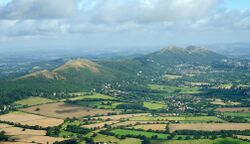Earth:Hill chain
A hill chain, sometimes also hill ridge, is an elongated line of hills that usually includes a succession of more or less prominent hilltops, domed summits or kuppen, hill ridges and saddles and which, together with its associated lateral ridges and branches, may form a complex topographic structure. It may occur within a hill range, within an area of low rolling hill country or on a plain. It may link two or more otherwise distinct hill ranges. The transition from a hill chain to a mountain chain is blurred and depends on regional definitions of a hill or mountain. For example, in the UK and Ireland a mountain must officially be 600 m (2,000 ft) or higher,[1][2] whereas in North America mountains are often (unofficially) taken as being 1,000 ft (300 m) high or more.[3]
The chain-like arrangement of hills in a chain is a consequence of their collective formation by mountain building forces or ice age earth movements. Hill chains generally have a uniform geological age, but may comprise several types of rock or sediment.
Hill chains normally form a watershed. They are crossed by roads that often use a natural saddle in the terrain.
Examples
- the Argonne hill chain, in France .[4]
- the Fläming south of Berlin in Germany .[5]
- the Malvern Hills in central England .[6]
- the ridge between the Taunus and Vogelsberg, which lies south of Giessen and forms the watershed between the Lahn valley and the Wetterau in Germany .
See also
References
- ↑
- Nuttall, John & Anne (2008). England. 2 (3rd ed.). Milnthorpe, Cumbria: Cicerone. ISBN 978-1-85284-037-2.
- "Survey turns hill into a mountain". BBC News. Archived from the original on 2 October 2013. https://web.archive.org/web/20131002232825/http://news.bbc.co.uk/2/hi/uk_news/wales/north_west/7623904.stm. Retrieved 3 February 2013. - "A Mountain is a Mountain – isn't it?". Archived from the original on 8 February 2013. https://web.archive.org/web/20130208122551/http://www.go4awalk.com/uk-mountains-and-hills/a-mountain-is-a-mountain.php. Retrieved 3 February 2013.
- "mountain". Archived from the original on 5 February 2013. https://web.archive.org/web/20130205033435/http://dictionary.reference.com/browse/Mountain. Retrieved 3 February 2013.
- Wilson, Peter (2001). "Listing the Irish hills and mountains". Irish Geography (Coleraine: University of Ulster) 34 (1): 89. doi:10.1080/00750770109555778. Archived from the original on 27 June 2013. https://www.webcitation.org/6HgLY5lsv?url=http://www.ucd.ie/gsi/pdf/34-1/hills.pdf.
- Nuttall, John & Anne (2008). England. 2 (3rd ed.). Milnthorpe, Cumbria: Cicerone. ISBN 978-1-85284-037-2.
- ↑ "What is a "Mountain"? Mynydd Graig Goch and all that...". Archived from the original on 30 March 2013. https://web.archive.org/web/20130330062754/https://metricviews.org.uk/2008/09/what-is-a-mountain-mynydd-graig-goch-and-all-that/. Retrieved 3 February 2013.
- ↑ "What is the difference between lake and pond; mountain and hill; or river and creek?". USGS. Archived from the original on 9 May 2013. https://web.archive.org/web/20130509082833/http://gallery.usgs.gov/audios/127. Retrieved 11 February 2013.
- ↑ Leggiere 2007, p. 122.
- ↑ Bünz 2008, p. 131.
- ↑ Stebbing 1940, p. 61.
Literature
- Stebbing, W.P.D. (1940). "Some early references to geology from the sixteenth century onwards". Proceedings of the Geologists' Association 51 (2): 49–63.
- Bünz, Enno (2008). Ostsiedlung und Landesausbau in Sachsen. Leipzig: Leipziger Universitätsverlag.
- Leggiere, Michael V. (2007). The Fall of Napoleon. 1. Cambridge University Press.
External links
 |


